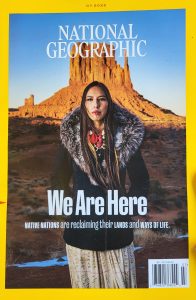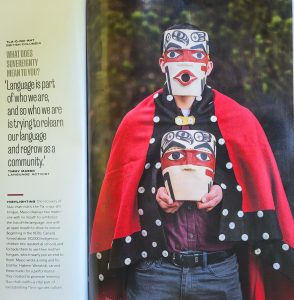

Images copyright National Geographic 2022. Cover image (left) features Quannah Rose Chasing-horse, a model who advocates for Native sovereignty, photo credit Kiliii Yuyan. Image to the right features Timmy Masso of the Tla-o-qui-aht nation, displaying two masks carved by his brother, Hjalmer Wenstob, symbolizing the loss of the Nuu-chah-nulth language and its revival, photo credit Kiliii Yuyan.
Part of my understanding of what engagement in reconciliation means is to recognise and celebrate the resilience and success of Indigenous communities. The cover story in the July edition of National Geographic is titled “We Are Here” and features five different Indigenous nations and their progress in regaining some control over their traditional territories, and what sovereignty means to them. One of the Nations features is the Tla-o-qui-aht on Vancouver Island.
The Tla-o-qui-aht Ha’houlthee (homeland) is located on the rugged West coast of Vancouver Island, and covers Tofino and many islands within Clayoquot Sound. Having spent some time in Port Renfrew recently, home of the Pacheedaht Nation, I have seen the impact of clear-cut logging in this part of the Island, and the ugly mess it leaves behind. As the article says, this part of the Island has been logged “and logged badly”. Saya Masso, head of the Tla-o-qui-aht nautral resources department, sums it up in his quote “They came and left… And they didn’t restore the land, and neither did British Columbia or Canada. So we’re doing it”. The article goes on to describe the environmental restoration work that the Tla-o-qui-aht are doing, and their mission to develop a unit of parks guardians to safeguard the land.
They are also working to develop a Tla-o-qui-aht school system, language revitalisation program, and improve health care. They seek sovereignty, which is defined in most Western dictionaries in terms of supreme authority, typically over a body politic or land. However, as quoted in the article, Leroy Little Bear of the Kainai (Blood) describes it differently: “The closes English term that I know to what we mean by sovereignty is ‘self-actualization’… Sovereignty is having access to all of ourselves”
The idea of Indigenous sovereignty as being more than a system of government, but also encompassing ideas of personal fulfillment and growth, reminded me of how much we could learn from Indigenous communities. The well-being of their people is inextricably linked to the care-taking of the land. Nurturing the territory is both a responsibility and a privilege that seems integrated with personal growth and development in a way that simply isn’t present in mainstream white culture, in my experience at least. How different would the world be if Indigenous ways of knowing and living were universally recognised and valued.
Catharine Winstanley, July 20th 2022